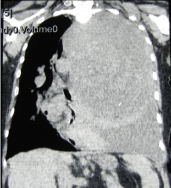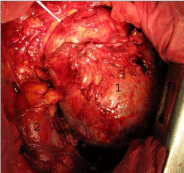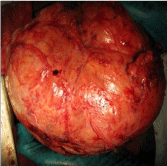Research Article
Solitary Fibrous Tumors of the Pleura: How to remove it?
Motus I1*, Altman E2, Grinberg L1, Bar-Haim R2, Khalifa M2, Gurevich A2, Gavrilov A2, Samohvalov A2, Makhoul N2, Bazhenov A1 and Vishnya J1
1Department of Thoracic Surgery, Urals Research Institute for Phthisiopulmonology, Russia
2Department of Thoracic Surgery, Western Galilee Hospital, Israel
*Corresponding author: Motus I, Department of Thoracic Surgery, Urals Research Institute for Phthisiopulmonology, Ekaterinburg Regional Pulmonologic Centre, Ekaterinburg, Russia
Published: 07 Mar, 2017
Cite this article as: Motus I, Altman E, Grinberg L, Bar-
Haim R, Khalifa M, Gurevich A, et al.
Solitary Fibrous Tumors of the Pleura:
How to remove it?. Clin Surg. 2017; 2:
1358.
Abstract
The data of 22 patients with solitary fibrous tumors of the pleura subjected to surgical treatment are
presented. A special attention is paid to the problem of surgical approach for removal of the tumor.
In 5 patients tumors were removed by video-assisted thoracoscopy. Thoracotomy was performed
in 12 patients. In 9 patients where tumors were 15 cm or more in diameter there were difficulties
during dissection the tumor and evacuation it from the pleural cavity. Additional lower thoracotomy
to dissect the lower part of the tumor and extract it from the cavity by “push-pull” manner was
performed in 2 cases. Full median sternotomy was performed in 3 patients where the tumor was
close to major blood vessels of the mediastinum, pleural cupola and lung hilus. Hemiclamshel
approach was performed in 2 patients. Transient haemodynamic collapse after removing the bulky
tumors occurred in 2 patients. One patient died after surgery from fibrinolytic bleeding occurred
after removal of a huge tumor via thoracotomy. Hospital complication and mortality rates were
13.6%, and 4.5% respectively. The choice of surgical access for removal of the tumor depends on the
CT picture and intraoperative situation. Creation of a definite protocol is of importance. A relative
rarity of these tumors makes it difficult to process.
Keywords: Solitary fibrous tumors; Tumor; Paraneoplastic symptoms
Introduction
Solitary fibrous tumors of the pleura (SFTP) are mostly benign ones so their clinical behavior usually does not show obvious symptoms. Slow growing and lack of symptoms result in the fact that SFTP can reach a huge size and are revealed as a bulky swelling with strong compression and displacement of adjacent anatomic structures. SFTP are relative rare with a prevalence of approximately 2.8 cases per 100,000 patients [1], so that majority of publications presents small numbers of cases. The aim of this study is to present our experience with a special attention to surgical aspects of the problem.
Materials and Methods
The data of 22 patients with SFTP operated upon in Thoracic surgical clinics of Urals Research Institute for Phthisiopulmonology, Ekaterinburg Regional Pulmonologic Centre (Russia) and in Western Galilee Hospital- Nahariya (Israel). Patients’ characteristics are presented in Table 1. No paraneoplastic symptoms were found in our patients. Chest radiograph revealed a delineated tumor mass in 14 patients (63.6%), and opacification of the complete hemithorax with atelectasis of the adjacent lung in 8 cases (36.4%). Computed tomography (CT) confirmed the symptoms presented in chest radiograph and showed signs of compression but not of invasion of the contiguous structures (Figure 1). Transthoracic fine needle aspiration biopsy was performed in 6 patients and in 3 cases diagnosis of pleural fibrous tumor was suspected. In 3 cases of giant tumors where malignancy was suspected the biopsy specimens were obtained via small incision and benign pleural fibrous tumor was confirmed. In 2 patients in other hospitals attempts to remove the tumors were undertaken but only exploratory thoracotomies were performed. In both cases biopsies were performed and SFTP were confirmed. Morphologic criteria of malignancy were as follows: nuclear atypia, or hypercellularity, necrosis, more than 4 mitoses per 2 mm, polymorphism, vascular or stromal invasion [2]. The decision about operative approach was based on CT scan data and mainly depended on the size and location of the tumor. In 4 patients pedunculated tumors were removed by VATS. In 1 patient wedge lung resection was performed also by means of VATS. Lateral thoracotomy was eligible for removing the tumor of either parietal or visceral pleura. Full median sternotomy was performed in 3 patients where the tumor was close to major blood vessels of the mediastinum, pleural cupola and lung hilus. Two patients of these 3 were previously subjected to exploratory thoracotomy in other hospitals where the tumor was considered inoperable. Hemiclamshel approach was undertaken in 2 cases also because of suspected mediastinal invasion. Special attention in any case was paid to the detection and ligation of feeding vessels, which were within adhesions between the tumor and the mediastinum (Figure 2). In 2 patients with huge tumors where diaphragmatic involvement was suspected additional lower thoracotomy in VIIVIII intercostal space was performed in order to separate the tumor from the diaphragm and to make easier its extraction from the pleural cavity by “push-pull” manner (Figure 3).
Table 1
Figure 1
Figure 2
Figure 2
Left thoracotomy. The tumor was divided from the mediastinum
and chest wall.
1- Tumor, 2- Aortic arch.
Results
The features revealed after the operation are presented in Table 3.
All malignant tumors were symptomatic, sessile, and larger than 15 cm
in diameter. Malignancy was established at morphologic examination
of the whole removed specimen but not at the preoperative biopsy.
Extra pleural dissection became necessary in 11 cases including 9
bulky tumors mentioned above but only in 2 patients with malignant
SFTP the invasion of pericardium and diaphragm was found at
morphologic examination. No metastases were found in the removed
lymph nodes.
One patient died after surgery from fibrinolytic bleeding
occurred after removal of a huge tumor via thoracotomy. In 2
patients vasopressor support was necessary because of transient
haemodynamic collapse after removing bulky tumors. So the hospital
complication and mortality rates were 13.6% and 4.5 % respectively.
Thirteen patients of 17 with benign SFTP were followed in the period
from 6 to 36 months after the operation. All they were free of the
disease. Three patients with malignant tumors were followed in the
period from 1 to 2 years, and no recurrence was noted. Adjuvant
radiation therapy was given to 2 of them.
Figure 3
Figure 3
The tumor is pushing from the additional lower thoracotomy
performed in the VII intercostal space and extracting from the pleural cavity
by “push-pull” manner.
Table 2
Table 3
Discussion
Chest radiograph and CT scan in SFTP demonstrated a huge tumor with compressive atelectasis of the lung, displacement of the mediastinum and diaphragm. Preoperative diagnosis of SFTP was established on the base of CT scan in 45% [3], 92% [4]. Accurate assessment of resectability is difficult even when CT is performed with contrast enhancement. Angiography can be of help to disclose aortic invasion and discover tumor feeding vessels. Angiography was also used for feeding vessels embolization which is considered important in cases of very large tumors [5]. It should be noted that angiography is important not only for embolization, but also for helping the surgeon to find the vessels concerned at the operation. Preoperative transthoracic needle biopsy is not recommended mainly because of its uncertain rate of diagnostic accuracy which was reported to be from 25% [3] to 80% [6]. More than that it often does not disclose if the tumor is malignant or benign because of its heterogeneity. So it does not influence surgical tactics [6-9]. Radical dissection remains an indispensable condition in the treatment of SFTP irrespective of its morphologic structure. Transthoracic needle biopsy remains to be necessary to obtain a histopathologic diagnosis in patients where surgery is impossible by any reasons [4,10]. Surgery is a gold standard in the treatment of SFTP with special attention to perform en block removal of the tumor and the resection margins being free of the neoplastic tissue [3,6-8,10,11]. Intraoperative pathologic examination of the margins should be undertaken when any doubts exist [3,11]. Although it was noted that displacement or adhesion but not invasion of adjacent structures was a characteristic property of SFTP [12,13], vascularized adhesions complicate surgery and can provoke bleeding. It took place in 5 of our cases with 1 lethal outcome. Firm adhesions with the parietal pleura require extrapleural dissection [7,8,11]. Implementation of these considerations requires adequate surgical access. Small pedunculated tumors are to be removed by VATS what was successfully performed in 5 our cases and no conversion was necessary. A huge tumor occupying whole pleural cavity and penetrating to the mediastinum, lung and diaphragm raises a number of surgical problems. The swelling is hardly displaceable so that manipulations for its dissection in very deep and narrow space between the tumor and neighboring structures are difficult. Disclosure of the sources of bleeding and control bleeding in these conditions is also hard. In this situation, duration of the dissection and removal of the tumor becomes a factor of significant importance. The operative approach and extent of surgical excision should be dictated by the tumor’s size and location [4]. The location of tumor and the surgeon’s preference are considered more decisive than the radiologist’s impression in terms of the choice of the surgical approach [6]. Thoracotomy remains to be the most popular surgical approach [5,10,11]. Full median sternotomy is required in cases where mediastinal vascular involvement is suspected. Full median sternotomy provides convenient and safe manipulations under direct vision close to major blood vessels of the mediastinum, pleural cupola and lung hilus [10,14]. This is particularly important given the passage of feeding vessels from the subclavian artery and its branches, as it was shown in the paper of Khan [5]. But these approaches do not provide a full review and the possibility of manipulations in the deep spaces, so difficulties emerge, as mentioned above. Furthermore, there are difficulties with extraction giant tumor from the pleural cavity. Hemiclamshel is considered to be an excellent incision with great exposure [4], but it is to be stressed this approach is rather traumatic. The second way to solve this problem is to create an additional lower thoracotomy to dissect the lower part of the tumor and extract it from the cavity by “push-pull” manner [12]. We used both aforementioned methods. We consider the second one less traumatic and preferable when diaphragm involvement is suspected. It is important to make a decision about additional thoracotomy promptly in order to avoid delays of the operation and increase of bleeding. A combined approach comprising the neck incision, median sternotomy, and thoracotomy was presented [5] but we never had to resort to such extensive access for either surgery of the mediastinal tumors [14] or for removing the SFTP. Resection of the tumor portion by portion as described by Kim [15,16] should not be recommended because there is a threat of bleeding, and the spread of tumor cells and thus, early tumor recurrence.
Conclusion
Three surgical approaches are applied in cases of bulky SFTP namely sternotomy, hemiclamshel, and thoracotomy including one with additional lower approach. There is no standard decision in this issue, and in each case the choice of method depends on the specific conditions. A present study reflects the experience of two clinics in different countries. Surgeons of both teams share the same tactics in the choice of surgical approach in the treatment of SFTP. Creation of a definite protocol is of importance. A relative rarity of these tumors makes it difficult to process. Our study can be considered as one of the attempts to solve this problem.
References
- Ehsan HLS, Gibbs AR, Butchart EG. A giant pleural fibrous tumor. J Thorac Cardiovasc Surg. 2005; 130: 1216-1217.
- Travis WD, Brambilla E, Burke AP, Marx A, Nicholson AG. WHO Classification of Tumours of the Lung, Pleura, Thymus and Heart. Lyon: International Agency for Research on Cancer. 2015.
- Boddaert G, Guiraudet P, Venissac N, Le Pimpec-Barthes F, Mouroux J, Riquet M. Solitary Fibrous Tumors of the Pleura: A Poorly Defined Malignancy Profile. Ann Thorac Surg. 2015; 99: 1025-1031.
- Harrison–Phipps KM, Nichols FC, Schleck CD, Deschamps C, Cassivi SD, Schipper PH, et al. Solitary fibrous tumors of the pleura: Results of surgical treatment and long-term prognosis. J Thorac Cardiovasc Surg. 2009; 138: 19-25.
- Khan JH, Rahman SB, Clary-Macy C, Kerlan RK, George TI, Hall TS, et al. Giant Solitary Fibrous Tumor of the Pleura. Ann Thorac Surg. 1998; 65: 1461-1464.
- Sung SH, Chang J-W, Kim J, Lee KS, Han J, Park SI. Solitary fibrous tumors of the pleura: surgical outcome and clinical course. Ann Thorac Surg. 2005; 79: 303-307.
- Rena O, Filosso PL, Papalia E, Molinatti M, Marzio PD, Maggi G, et al. Solitary fibrous tumour of the pleura: surgical treatment. Eur J Cardiothorac Surg. 2001; 19:185-189.
- de Perrot M, Fischer MS, Brundler M-A, Sekine Y, Keshavjee S. Fibrous Tumors of the Pleura. Ann Thorac Surg. 2002; 74: 285-293.
- Foroulis CN, Rammos KS, Tsomkopoulos S, Sileli MN, Hatzibougias I, Papakonstantinou C. Fibrous tumor of the lung: diagnostic and therapeutic considerations apropos of two cases. J BUON. 2008; 13: 117-121.
- Lahon B, Mercier O, Fadel E, Ghigna MR, Petkova B, Mussot S, et al. Solitary Fibrous Tumor of the Pleura: Outcomes of157 Complete Resections in a Single Center. Ann Thorac Surg. 2012; 94: 394-400.
- Cardillo G, Carbone L, Carleo F, Masala N, Graziano P, Bray A, et al. Solitary fibrous tumors of the pleura: an analysis of 110 patients treated in a single institution. Ann Thorac Surg. 2009; 88: 1632-1637.
- Hu CK, Chang YL, Lin WC, Lee YC. Resection of a giant thoracic solitary fibrous tumor through two separate thoracotomies. J Thorac Cardiovasc Surg. 2008; 136: 1077-1079.
- Shaker W, Meatchi T, Dusser D, Riquet M. An unusual presentation of solitary fibrous tumor of the pleura: right atrium and inferior vena cava compression. Eur J Cardiothorac Surg. 2002; 22: 640-642.
- Motus I, Bazhenov A, Massard G. Surgery for huge mediastinal tumors. Asian Cardiovasc Thorac Ann. 2015; 23: 846-850.
- Kim J. In discussion in the paper of Harrison–Phipps [3].
- Magdeleinat P, Alifano M, Petino A, LeRochais JP, Dulmet E, Galateau F, et al. Solitary fibrous tumors of the pleura: clinical characteristics, surgical treatment and outcome. Eur J Cardiothorac Surg. 2002; 21: 1087-1093.




